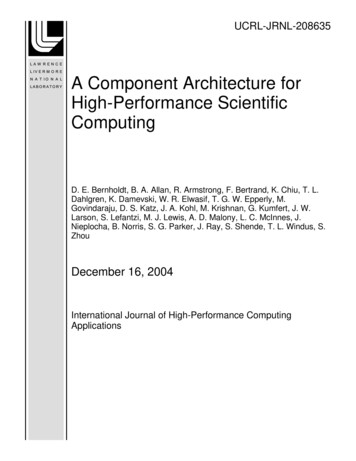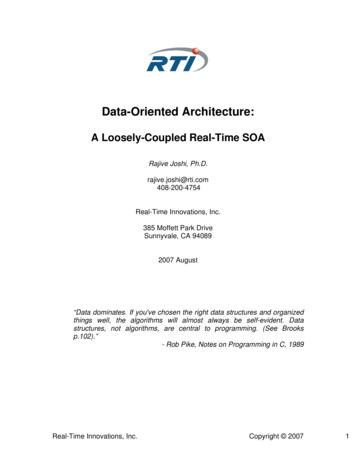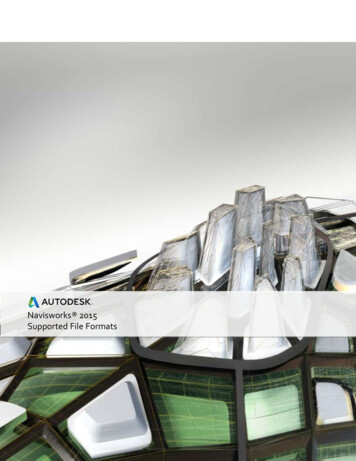
Transcription
UCRL-JRNL-208635A Component Architecture forHigh-Performance ScientificComputingD. E. Bernholdt, B. A. Allan, R. Armstrong, F. Bertrand, K. Chiu, T. L.Dahlgren, K. Damevski, W. R. Elwasif, T. G. W. Epperly, M.Govindaraju, D. S. Katz, J. A. Kohl, M. Krishnan, G. Kumfert, J. W.Larson, S. Lefantzi, M. J. Lewis, A. D. Malony, L. C. McInnes, J.Nieplocha, B. Norris, S. G. Parker, J. Ray, S. Shende, T. L. Windus, S.ZhouDecember 16, 2004International Journal of High-Performance ComputingApplications
DisclaimerThis document was prepared as an account of work sponsored by an agency of the United StatesGovernment. Neither the United States Government nor the University of California nor any of theiremployees, makes any warranty, express or implied, or assumes any legal liability or responsibility forthe accuracy, completeness, or usefulness of any information, apparatus, product, or processdisclosed, or represents that its use would not infringe privately owned rights. Reference herein to anyspecific commercial product, process, or service by trade name, trademark, manufacturer, or otherwise,does not necessarily constitute or imply its endorsement, recommendation, or favoring by the UnitedStates Government or the University of California. The views and opinions of authors expressed hereindo not necessarily state or reflect those of the United States Government or the University of California,and shall not be used for advertising or product endorsement purposes.
A Component Architecture for High-Performance ScientificComputingDavid E. Bernholdt1, Benjamin A. Allan2, Robert Armstrong2, Felipe Bertrand3, KennethChiu3, Tamara L. Dahlgren4, Kostadin Damevski5, Wael R. Elwasif1, ThomasG. W. Epperly4, Madhusudhan Govindaraju6, Daniel S. Katz7, James A. Kohl1, ManojKrishnan8, Gary Kumfert4, J. Walter Larson9, Sophia Lefantzi10, Michael J. Lewis6, Allen D.Malony11, Lois C. McInnes9, Jarek Nieplocha8, Boyana Norris9, Steven G. Parker5, JaideepRay12, Sameer Shende11, Theresa L. Windus13, and Shujia Zhou14Submitted to Intl. J. High Performance Computing Applications, ACTS Collection Special Issue1 ComputerScience and Mathematics Division, Oak Ridge National Laboratory, P. O. Box 2008, Oak Ridge, TN 37831Computing R & D, MS 9915, PO Box 969, Sandia National Laboratories, Livermore, CA 94551-09693 215 Lindley Hall, Indiana University, 474054 Center for Applied Scientific Computing, Lawrence Livermore National Laboratory, P.O. Box 808, L-365, Livermore, CA 945515 Scientific Computing and Imaging Institute, University of Utah, 50 S. Central Campus Dr., Room 3490, Salt Lake City, UT 841126 Department of Computer Science, State University of New York (SUNY) at Binghamton, Binghamton, NY 139027 Jet Propulsion Laboratory, California Institute of Technology, 4800 Oak Grove Drive, Pasadena, CA 911098 Computational Sciences and Mathematics, Pacific Northwest National Laboratory, Richland, WA 993529 Mathematics and Computer Science Division, Argonne National Laboratory, 9700 South Cass Ave., Argonne, IL 60439-484410 Reacting Flow Research, MS 9051, PO Box 969, Sandia National Laboratories, Livermore, CA 94551-096911 Department of Computer and Information Science, University of Oregon, Eugene, OR 9740312 Advanced Software R & D, MS 9051, PO Box 969, Sandia National Laboratories, Livermore, CA 94551-096913 Pacific Northwest National Laboratory, Environmental Molecular Sciences Laboratory, P.O. Box 999, MS-IN: K8-91, Richland, WA 9935214 Northrop Grumman IT/TASC, 4801 Stonecroft Blvd, Chantilly, VA 201512 Scalable1
A Component Architecture for HPC2Corresponding Author:David E. BernholdtComputer Science and Mathematics DivisionOak Ridge National LaboratoryP. O. Box 2008, MS 6016Oak Ridge, TN 37831-6016 USAPhone: 1 865 574 3147Fax: 1 865 576 5491Email: bernholdtde@ornl.gov
A Component Architecture for HPC3AbstractThe Common Component Architecture (CCA) provides a means for software developers to manage the complexity of large-scale scientific simulations and to move toward a plug-and-play environment for high-performancecomputing. In the scientific computing context, component models also promote collaboration using independentlydeveloped software, thereby allowing particular individuals or groups to focus on the aspects of greatest interest tothem. The CCA supports parallel and distributed computing as well as local high-performance connections betweencomponents in a language-independent manner. The design places minimal requirements on components and thusfacilitates the integration of existing code into the CCA environment. The CCA model imposes minimal overhead tominimize the impact on application performance. The focus on high performance distinguishes the CCA from mostother component models. The CCA is being applied within an increasing range of disciplines, including combustionresearch, global climate simulation, and computational chemistry.
A Component Architecture for HPC41 IntroductionHistorically, the principle concerns of software developers for high-performance scientific computing have centered onincreasing the scope and fidelity of their simulations, and then increasing the performance and efficiency to address theexceedingly long execution times that can accompany these goals. Initial successes with computational simulationshave led to the desire for solutions to larger, more sophisticated problems and the improvement of models to reflectgreater levels of detail and accuracy. Efforts to address these new demands necessarily have included improvements toscientific methodology, algorithms, and programming models, and virtually always each advance has been accompanied by increases in the complexity of the underlying software. At the same time, the computer industry has continuedto create ever larger and more complex hardware in an attempt to satisfy the increasing demand for simulation capabilities. These architectures tend to exacerbate the complexity of software running on these systems, as in nearly allcases, the increased complexity is exposed to the programmer at some level and must be explicitly managed to extractthe maximum possible performance. In scientific high-performance computing, relatively little attention has been paidto improving the fundamental software development process and finding ways to manage the ballooning complexityof the software and operating environment.Simultaneously, in other domains of software development, complexity rather than runtime performance has beena primary concern. For example, in the business area the push has been less for increasing the size of “the problem”than for interconnecting and integrating an ever-increasing number of applications that share and manipulate businessrelated information, such as word processors, spreadsheets, databases, and web servers. More recently, with the fastpace of the internet boom, the flood of new software technology used in business and commercial applications hasincreased both the degree of interoperability desired and the number of applications and tools to be integrated. Thissituation has led to extreme software complexity, which at several levels is not unlike the complexity now being seenin high-performance scientific computing. For example, scientific codes regularly attempt the integration of multiplenumerical libraries and/or programming models into a single application. Recently, efforts are increasing to couplemultiple stand-alone simulations together into multi-physics and multi-scale applications for models with better overallphysical fidelity.One of the approaches that the business/internet software community has found invaluable in helping to addresstheir complexity conundrum is the concept of component-based software engineering (CBSE). The basic tenet of
A Component Architecture for HPC5CBSE is the encapsulation of useful units of software functionality into components. Components are defined bythe interfaces that they present to the outside world (i.e., to other components), while their internal implementationsremain opaque. Components interact only through these well-defined interfaces, and based on these interfaces can becomposed into full applications. Using this methodology enables use of the “plug-and-play” software approach forcreating complex applications. The smaller, task-specific units of software are more easily managed and understoodthan a complete application software structure. Logically, many components can provide functionality that is generallyuseful in a variety of different applications. In such cases, suitably well-designed components might be reusable acrossmultiple applications with little or no modification. It is also possible that a number of different components can exportthe same interface and provide the same essential functionality, but via different implementations, thereby allowingthese interoperable components to be swapped within an application in a plug-and-play fashion.These ideas have spawned a number of component architectures, some of which have become so widely used asto have reached “commodity” status: Microsoft’s Component Object Model (COM) [Microsoft Corporation, 1999],the Object Management Group’s Common Object Request Broker Architecture (CORBA) Component Model [ObjectManagement Group, 2002], and Sun’s Enterprise JavaBeans [Sun Microsystems, 2004a].While having proven quite popular and successful in the areas in which it originated, CBSE has made few inroadsinto the scientific computing community. Part of the reason is that serious scientific applications tend to be large,evolving, and long-lived codes whose lifetimes often extend over decades. In addition to a natural inertia that slowsthe adoption of new software engineering paradigms by scientific software developers, current commodity componentmodels present a variety of issues ranging from the amount of code that must be changed and added to adapt existing code to the component environment, to performance overheads, to support for languages, data types, and evenoperating systems widely used in scientific computing.The Common Component Architecture (CCA) Forum was launched in 1998 as a grass-roots effort to create acomponent model specifically tailored to the needs of high-performance scientific computing. The group’s goals areboth to facilitate scientific application development and to gain a deeper understanding of the requirements for anduse of CBSE in this community so that they can feed back into the development of future component models, in thehope that eventually this community too may be adequately served by “commodity” tools. In the intervening years,the Forum has developed a specification for the CCA as well as prototype implementations of many associated tools,
A Component Architecture for HPC6and the CCA is experiencing increasing adoption by applications developers in a number of scientific disciplines. Thispaper updates our previous overview paper in 1999 [Armstrong et al., 1998] to reflect the evolution of the CCA andour much more detailed understanding of the role of CBSE in scientific computing. We will discuss the special needsof this community, and we will describe in detail the Common Component Architecture and how it addresses theseneeds, as well as how it relates to other component models. We will provide some information about how scientificapplications are using the CCA now, and we will discuss open issues for CBSE development in this area.2 Components for Scientific ComputingComponent-based software engineering is a natural approach for modern scientific computing. The ability to easilyreuse interoperable components in multiple applications and the plug-and-play assembly of those applications havesignificant benefits in terms of productivity in the creation of simulation software, especially when the component“ecosystem” is rich enough that a large portion of the components needed by any given application will be available“off the shelf” from a component repository. The simplicity of plug-and-play composition of applications and the factthat components hide implementation details and provide more manageable units of software development, testing, anddistribution all help to deal with the complexity inherent in modern scientific software. Once the overall architectureof a software system and interfaces between elements of it (components) have been defined, individual softwaredevelopers or small groups can then focus on the creation of the components of particular scientific interest to them,while reusing software developed by others (often experts in their own domains) for other needed components ofthe system. Componentization also indirectly assists with the performance issues that are so critical in this area byproviding the ability to swap components with different implementations that are tailored to the platform of interest.Finally, components are a natural approach to handle the coupling of codes involving different physical phenomenaas well as different time scales and length scales, which is becoming increasing important as a means to improve thefidelity of simulations.In the scientific software world, CBSE is perhaps most easily understood as an evolution of the widespread practiceof using a variety of software libraries as the foundation on which to build applications. Traditional libraries alreadyoffer some of the advantages attributed above to components, but a component-based approach extends and magnifiesthe benefits. While it is possible for users to discover and use library routines that were not meant to be exposed
A Component Architecture for HPC7as part of the library’s public interface, component environments can enforce the public interface rigorously. It ispossible to have multiple instances (versions) of a component in a component-based application, whereas with plainlibraries, this is not generally possible. Finally, in a library-based environment, there are often conflicts of resourcemanagement, programming models, or other dependencies, which are more likely as increasing numbers of librariesare involved. With components, these concerns can often be handled by hooking up each “library” component tocomponents providing the resource management or programming model functionality.The use of domain-specific computational frameworks is another point of contact between current practice inscientific computing and CBSE. Domain-specific frameworks have become increasingly popular as environments inwhich a variety of applications in a given scientific domain can be constructed. Typically, the “framework” provides adeep computational infrastructure to support calculations in the domain of interest. Applications are then constructedas relatively high-level code utilizing the domain-specific and more general capabilities provided by the framework.Many frameworks support modular construction of applications in a fashion very similar to that provided by component architectures but typically limited to the higher-level parts of the code. However, domain-specific frameworkshave their limitations as well. Their domain focus tends to lead to assumptions about the architecture and workflowof the application becoming embodied in the design of the framework, making it much harder to generalize them toother domains. Similarly, since their development is generally driven by a small group of domain experts, it is rareto find interfaces or code that can be easily shared across multiple domain-specific frameworks. Unfortunately, thissituation is often true even with important cross-cutting infrastructure, such as linear algebra software, which could inprinciple be used with common interfaces across many scientific domains. Generic component models, on the otherhand, provide all the benefits of domain-specific frameworks, but by casting the computational infrastructure as wellas the high-level physics of the applications as components, they also provide easier extension to new areas, easiercoupling of applications to create multi-scale and multi-physics simulations, and significantly more opportunities toreuse elements of the software infrastructure.However, scientific computing also places certain demands on a CBSE environment, some of which are not easily satisfied by most of the commodity component models currently available. As noted above, performance is aparamount issue in modern scientific computing, so that to be acceptable in the community, a component model forscientific computing would have to be able to maintain the performance of traditional applications without imposing
A Component Architecture for HPC8undue overheads. (A widely used rule of thumb is that environments that impose a performance penalty in excessof ten percent will be summarily rejected by high-performance computing (HPC) software developers.) Commoditycomponent models have been designed (primarily or exclusively) for distributed computing and tend to use protocols that assume all method invocations between components must be made over the network, in environments wherenetwork latencies are often measured in tens and hundreds of milliseconds. This situation is in stark contrast to HPCscientific computing, where latencies on parallel interconnects are measured in microseconds, and traditional programming practices assume that on a given process in a parallel application, data can be “transferred” between methods bydirect reference to the memory location in which it lives. The performance overheads of the commodity componentmodels are often too high for scientific computing.In scientific computing, it is common to have large codes that evolve over the course of many years or even decades.Therefore, the ease with which “legacy” code bases can be incorporated into a component-based environment, and thecost of doing so, are also important considerations. Many of the commodity component models may require significantrestructuring of code and the addition of new code to satisfy the requirements of the model.Finally, also important to high-performance scientific computing are considerations including support for languages, data types, and computing platforms. The various commodity component models available may not supportFortran or may require extensive use of Java, may not support arrays as first-class data types or complex numbers, andmay even be effectively limited to Windows-based operating systems, which are not widely used in scientific HPC.The Common Component Architecture (CCA) was conceived to remedy the fact that a suitable component environment could not be found to satisfy the special needs of this community. Since its inception, the CCA efforthas grown to encompass a community of researchers, several funded projects, an increasing understanding of therole of CBSE in high-performance scientific computing, a maturing specification for the CCA component model, andpractical implementations of tools and applications conforming to that specification.3 The Common Component ArchitectureFormally, the Common Component Architecture is a specification of an HPC-friendly component model. This specification also provides a focus for an extensive research and development effort. On the research side, the effortemphasizes understanding how best to utilize and implement component-based software engineering practices in the
A Component Architecture for HPC9high-performance scientific computing arena, and feeding back that information into the broader component softwarefield. In addition to defining the specification, the development effort creates practical reference implementationsand helps scientific software developers use them to create CCA-compliant software, and ultimately, a rich marketplace of scientific components, thereby allowing new component-based applications to be built from predominantlyoff-the-shelf scientific components.3.1 Philosophy and ObjectivesThe purpose of the CCA is to facilitate an
7 Jet Propulsion Laboratory ,California Institute of T echnology 4800 Oak Gro ve Dri e, P asadena, CA 91109 8 Computational Sciences and Mathematics, P acic Northwest National Laboratory , Richland, W A 99352 9 Mathematics and Computer Science Di vision, Argonne National











